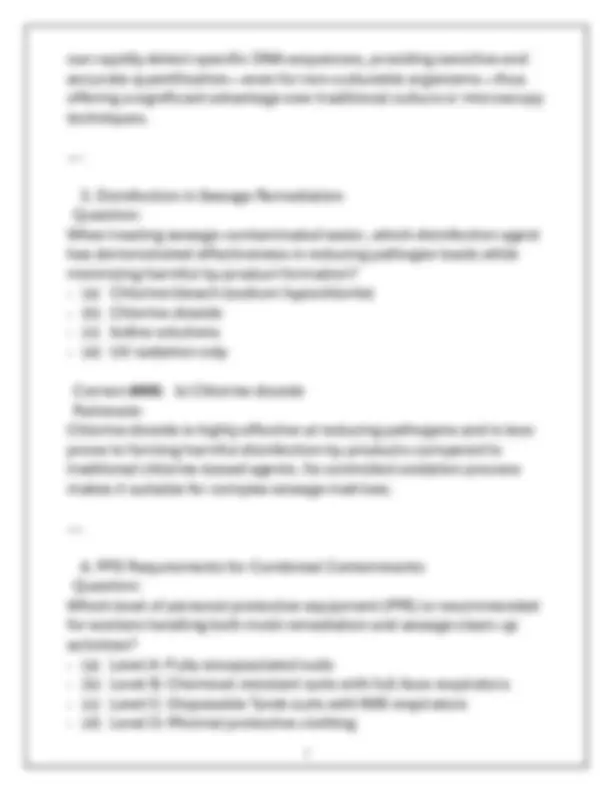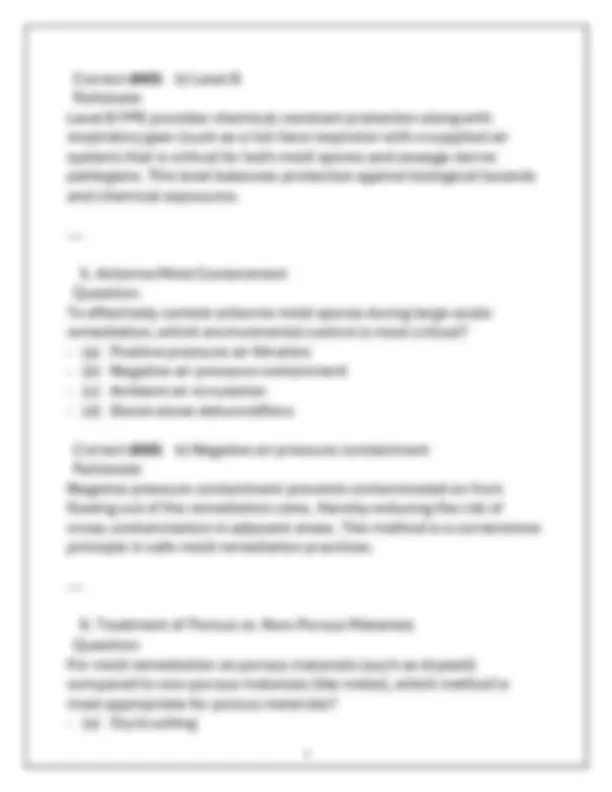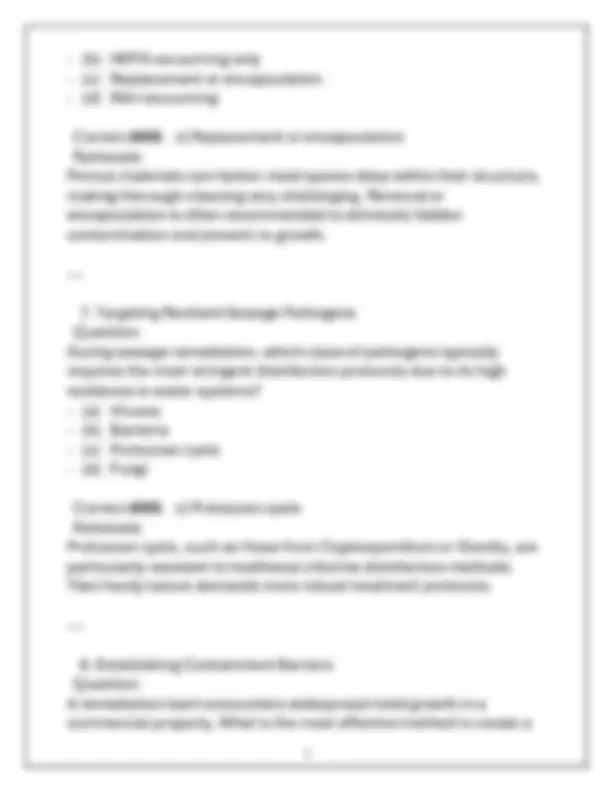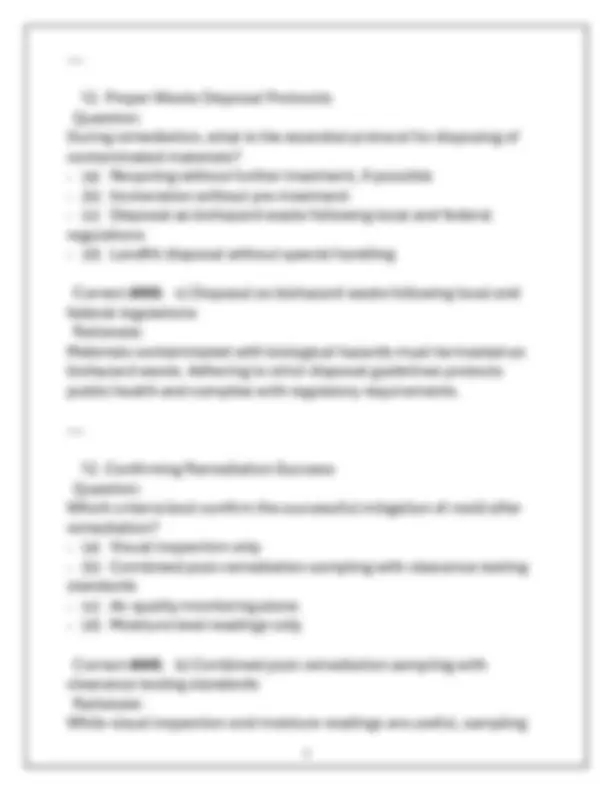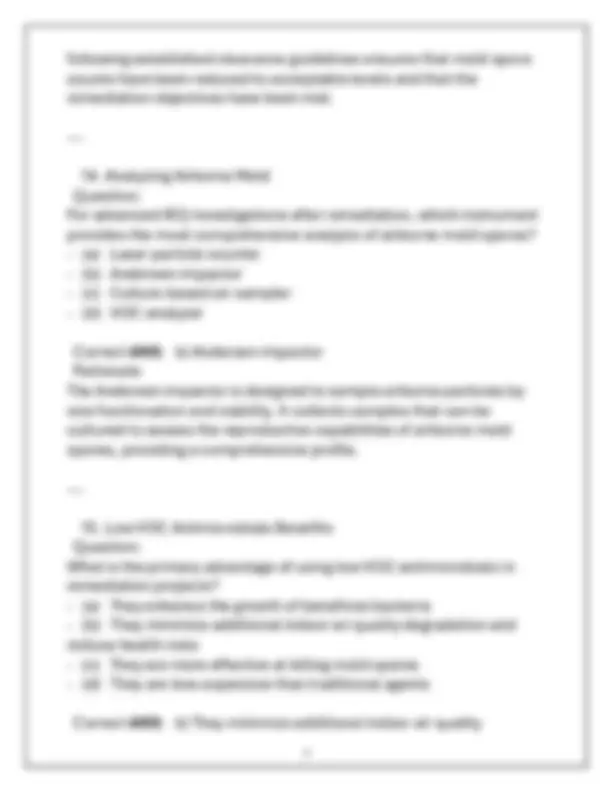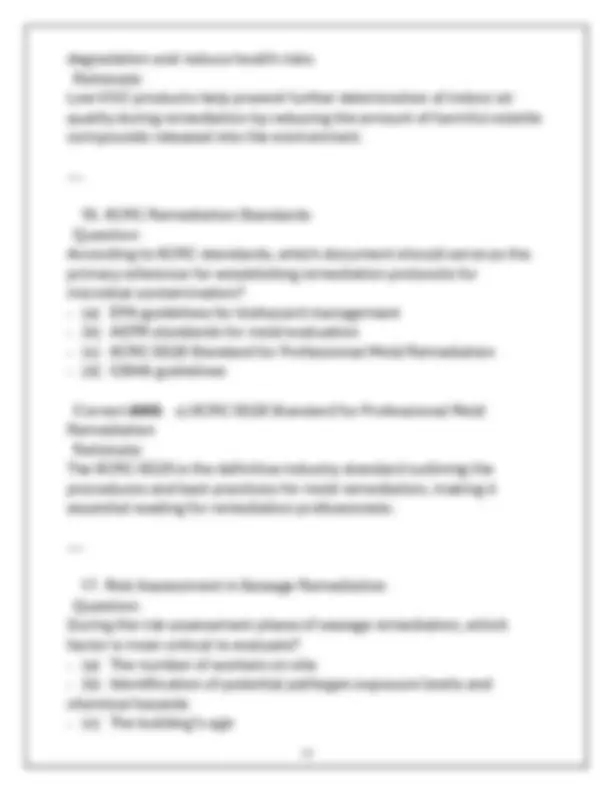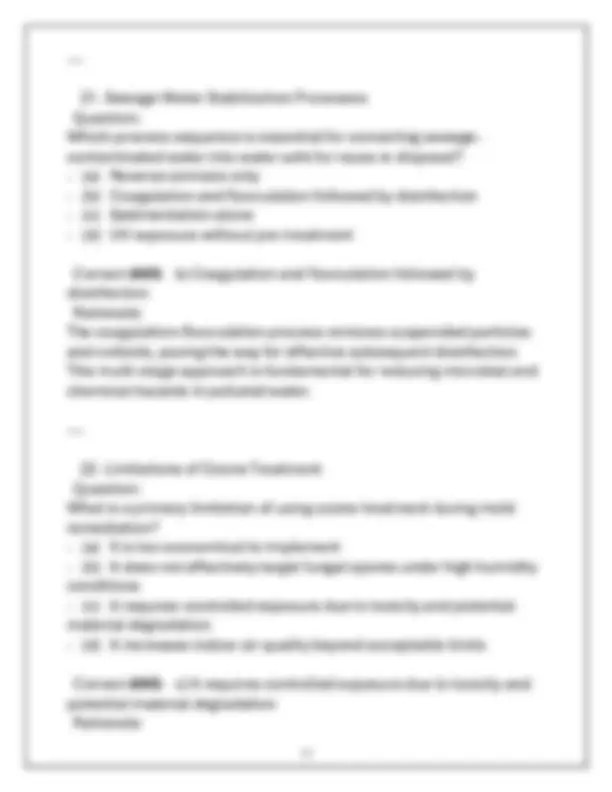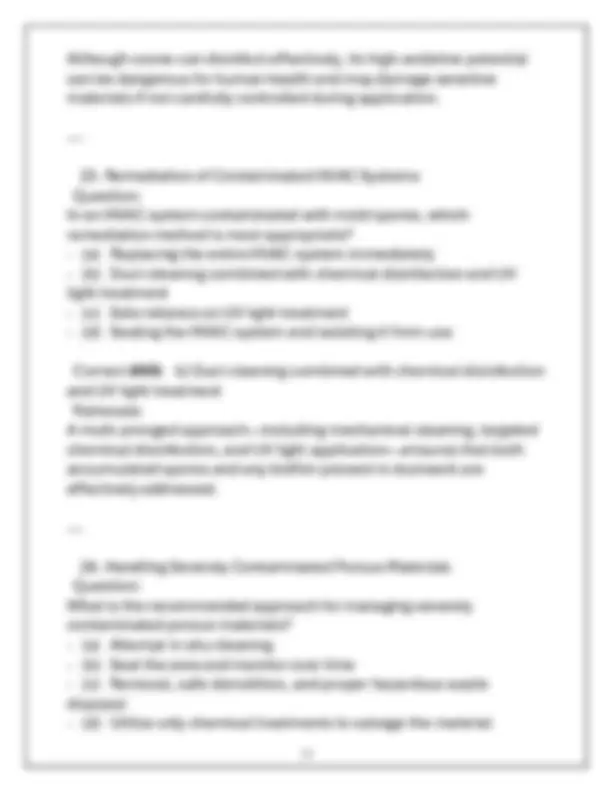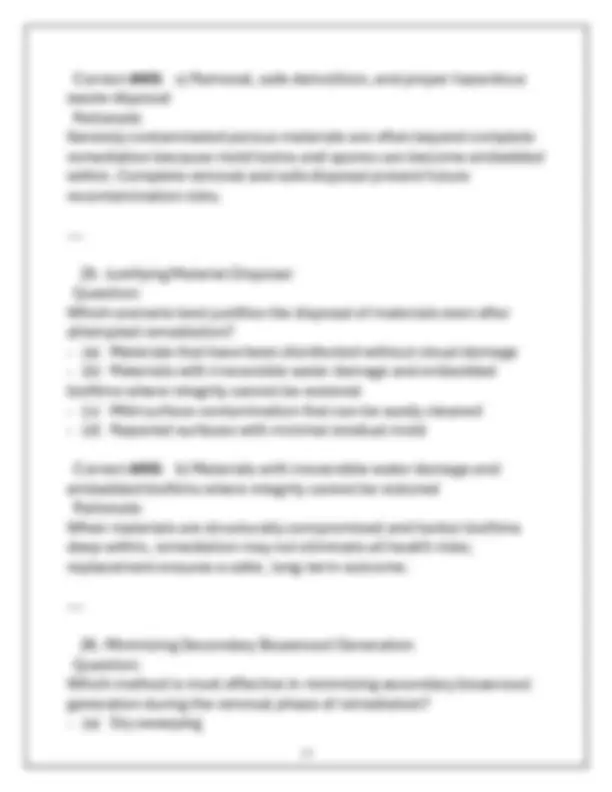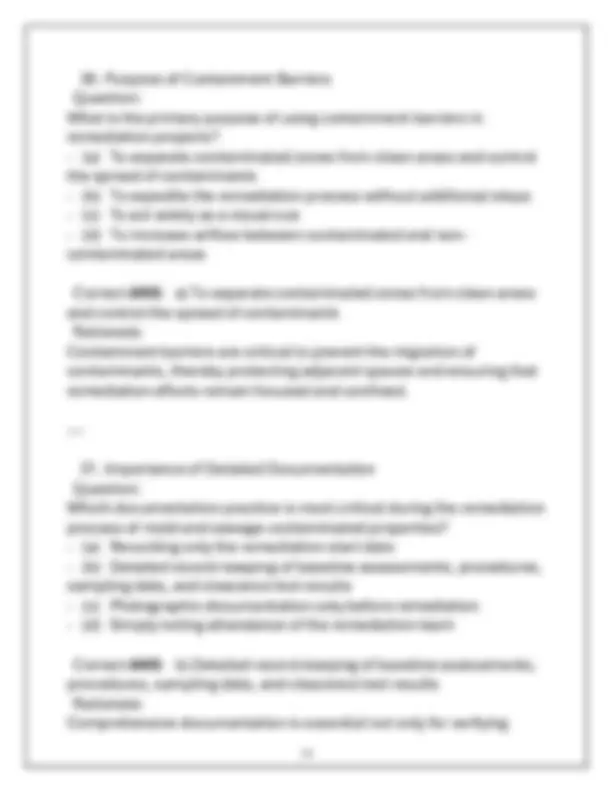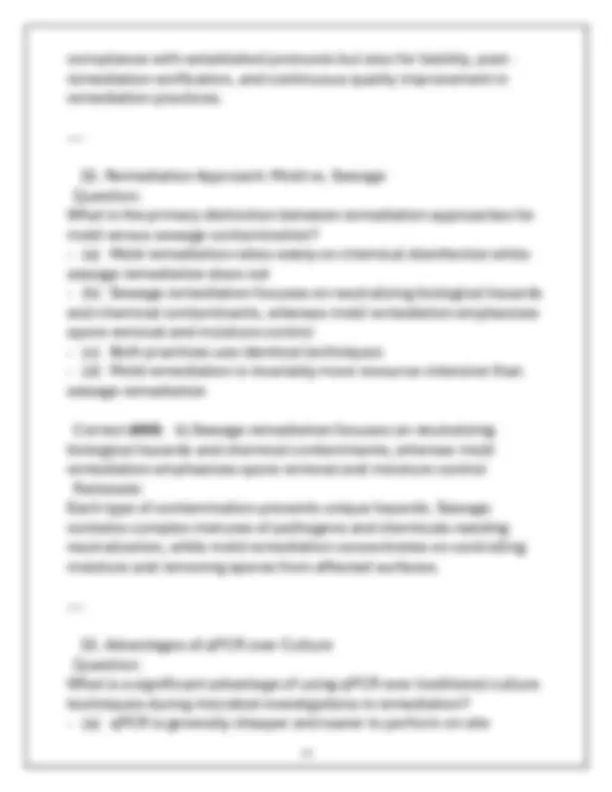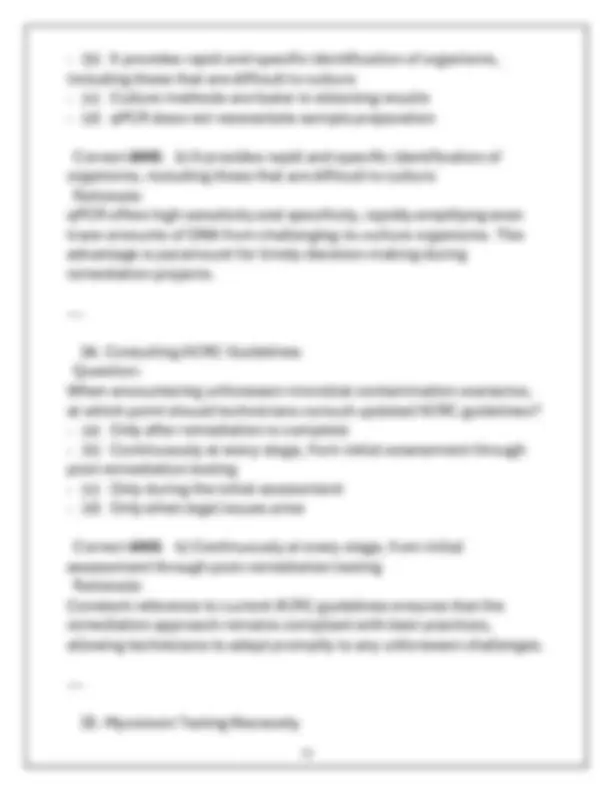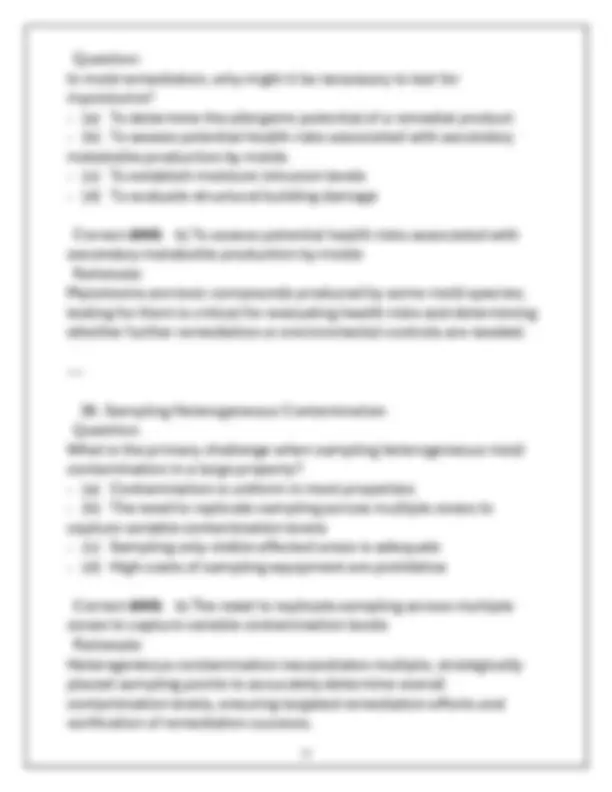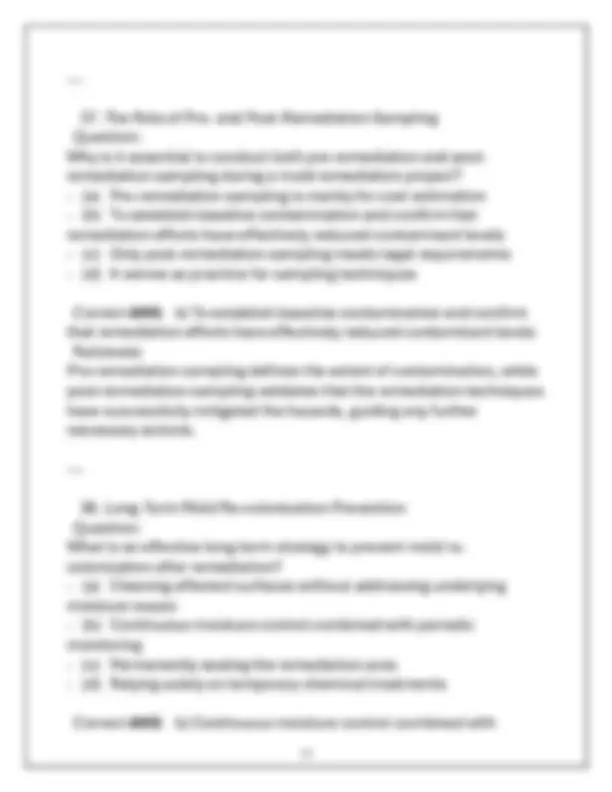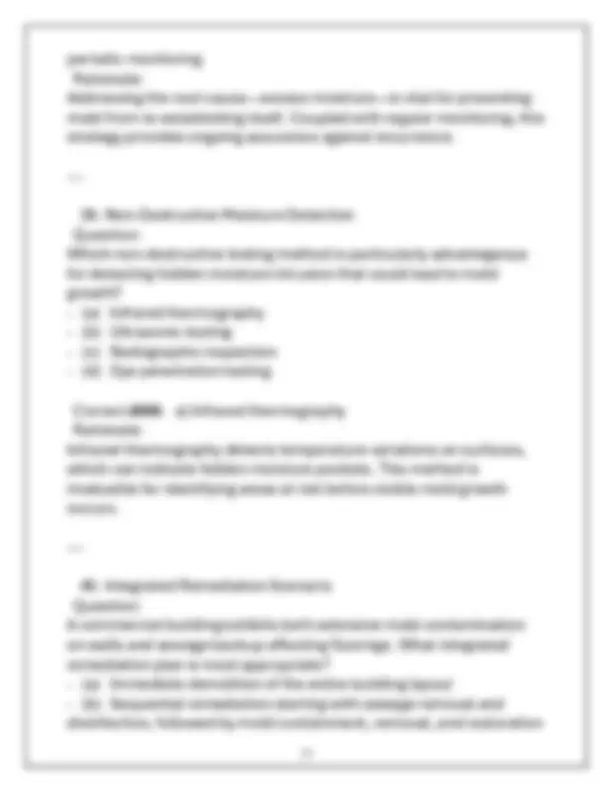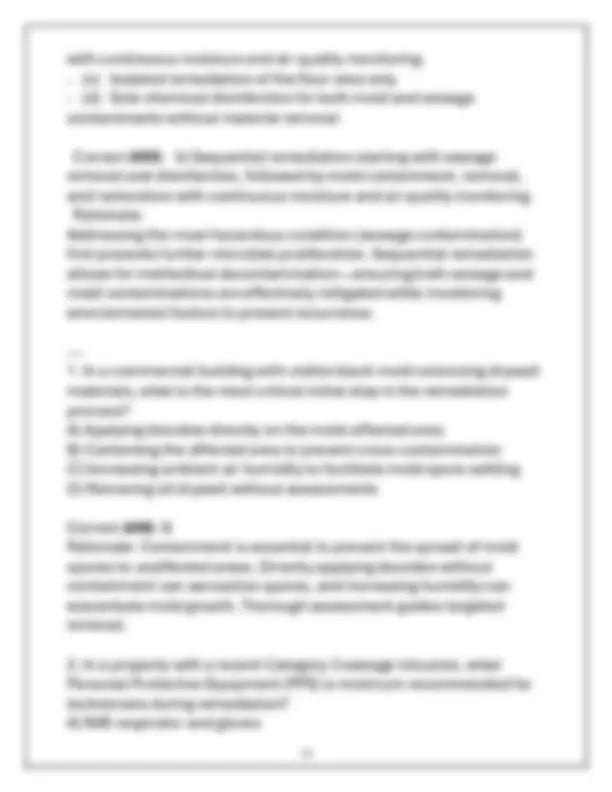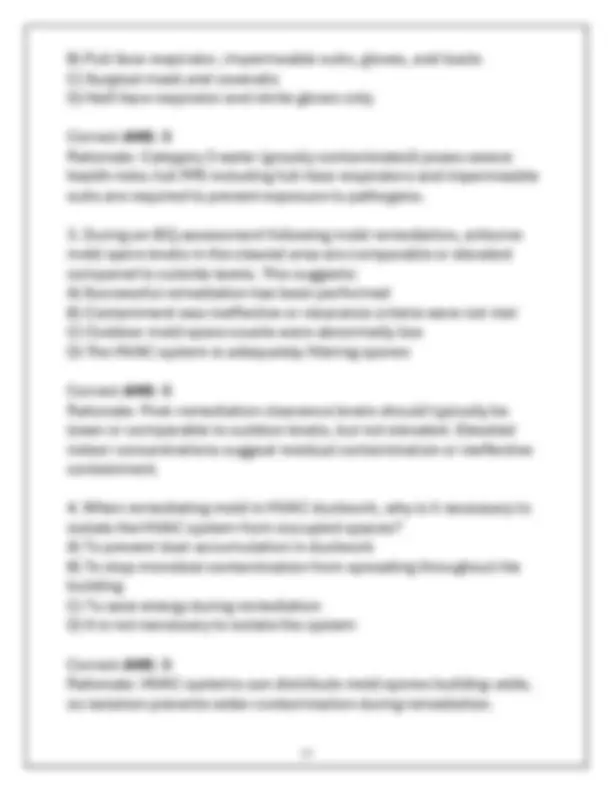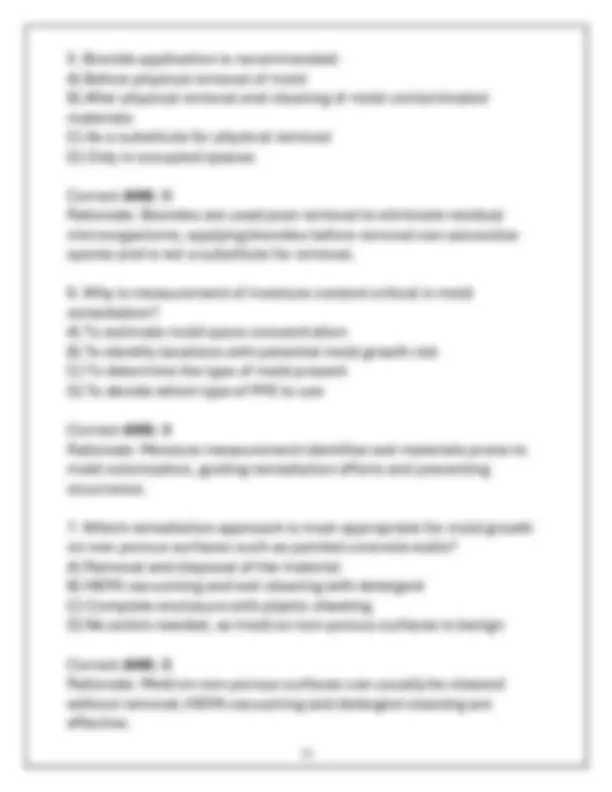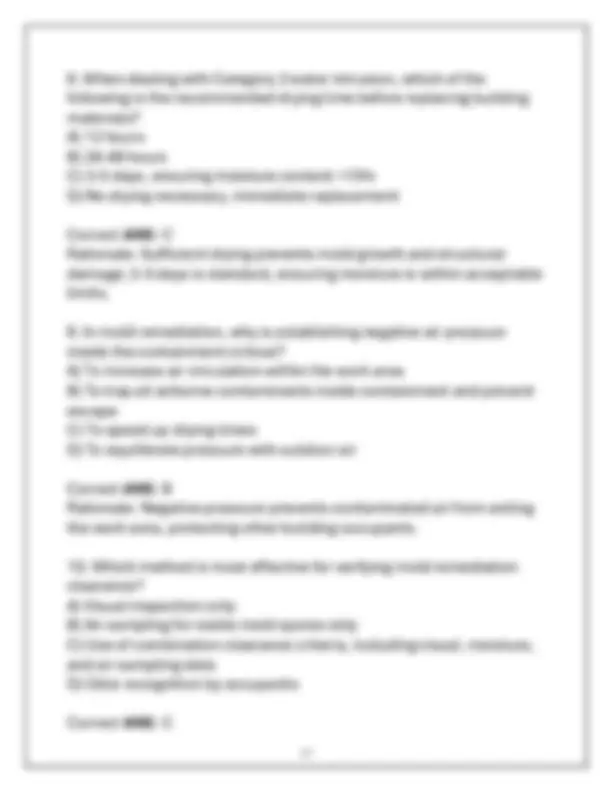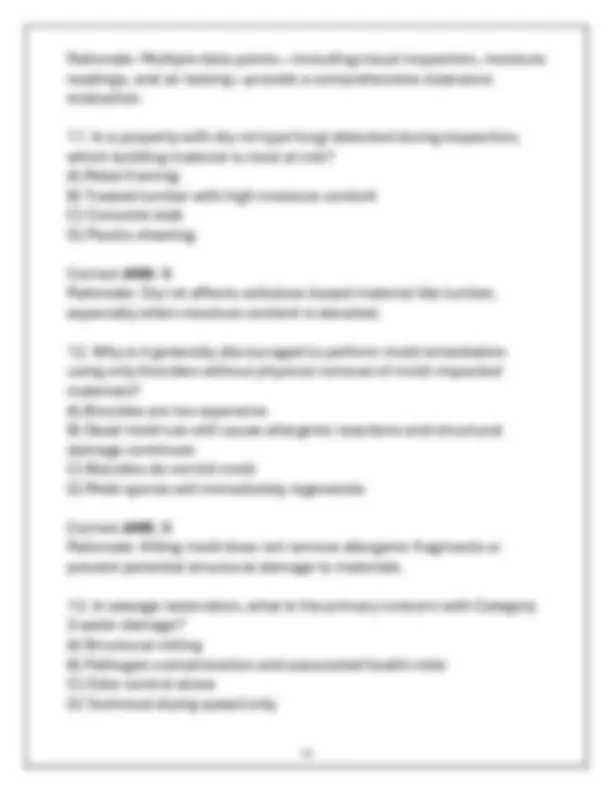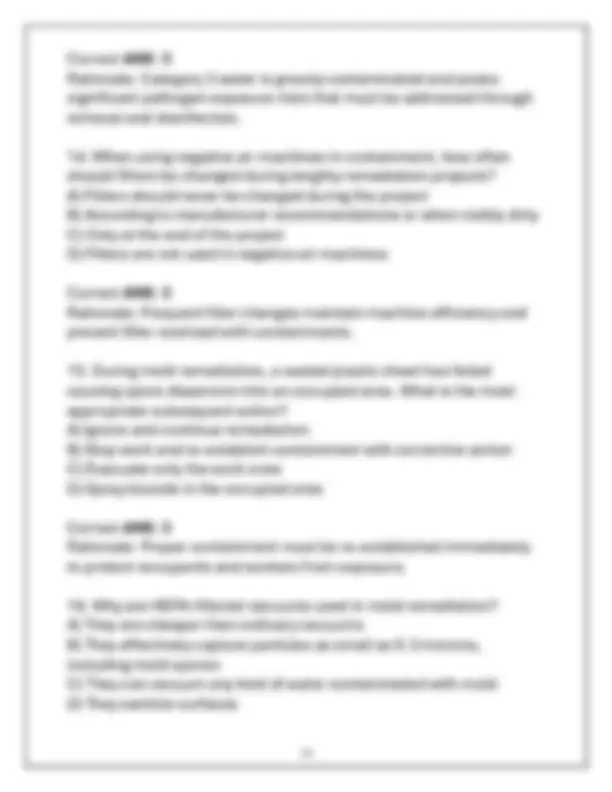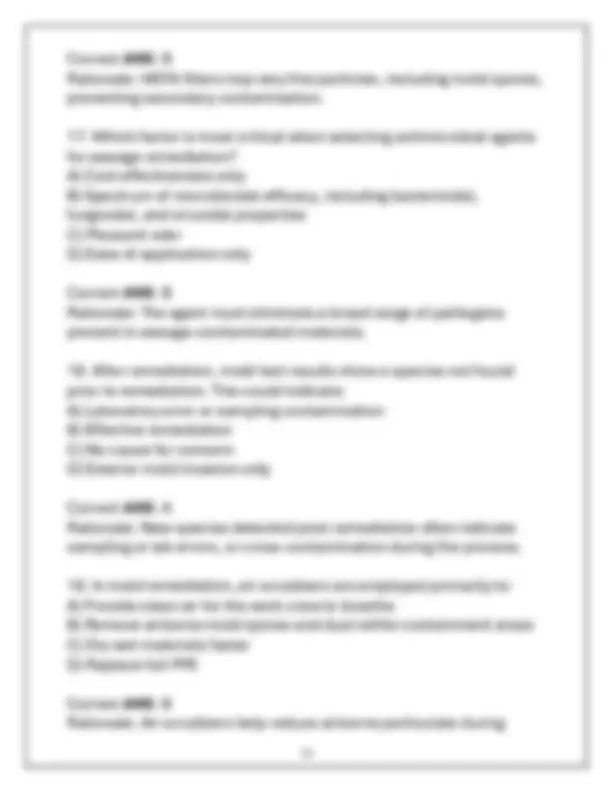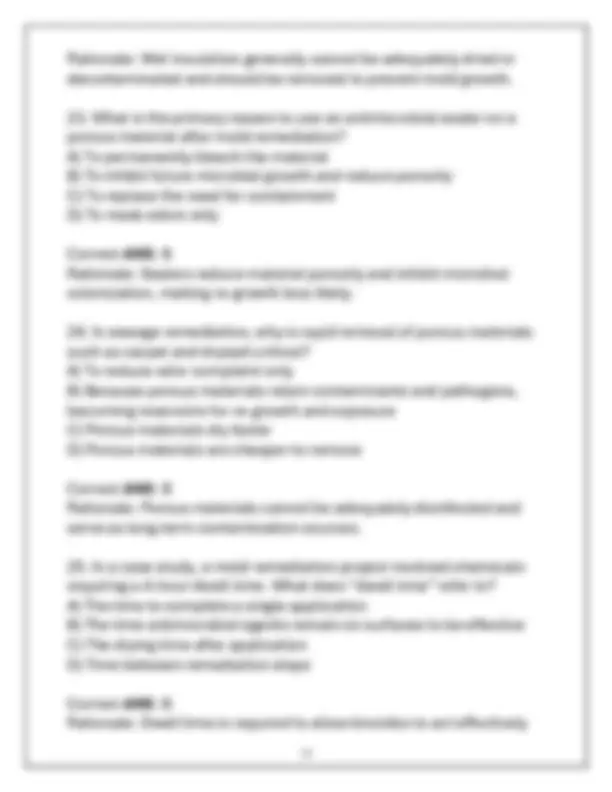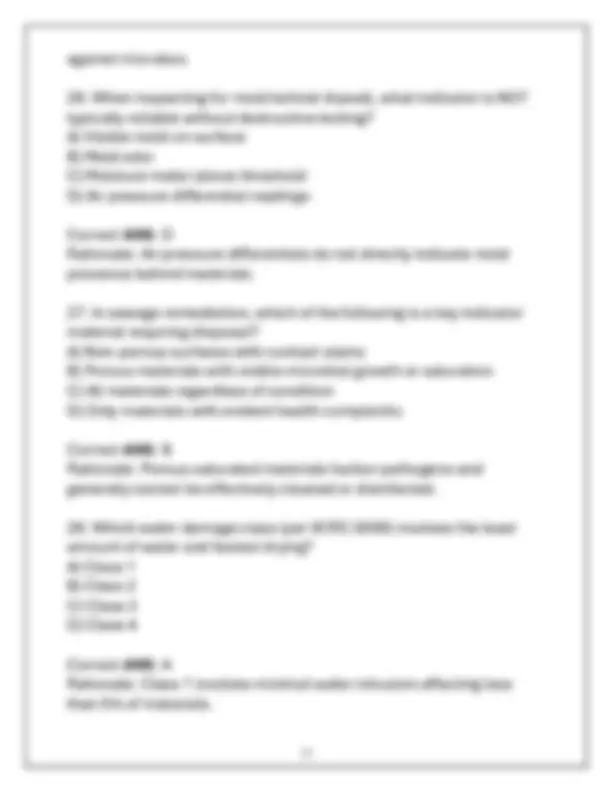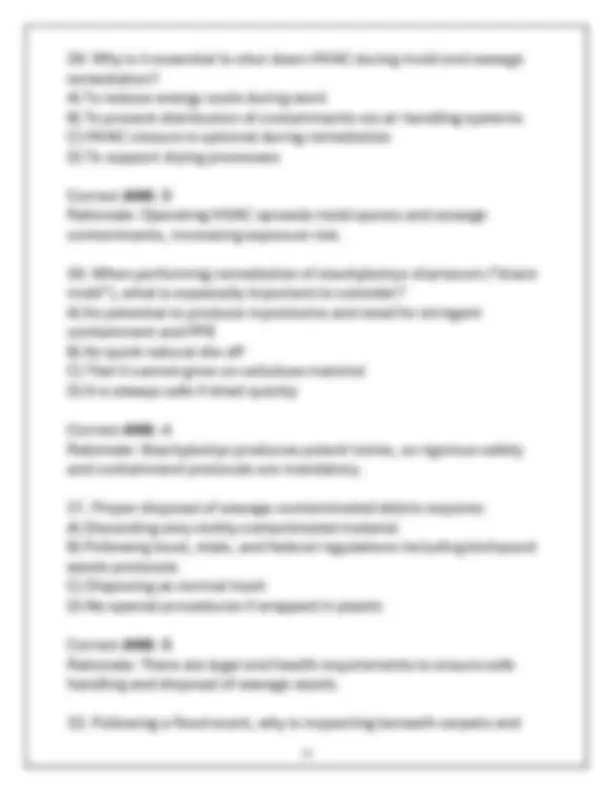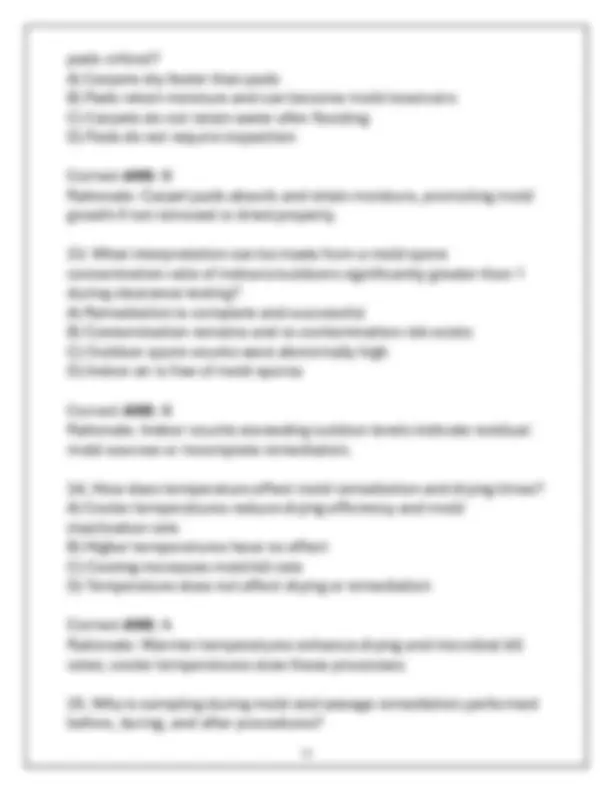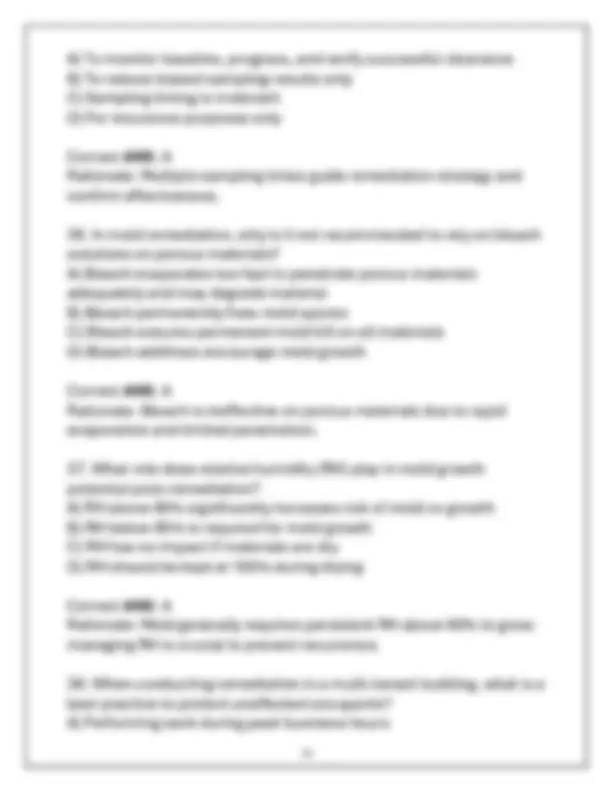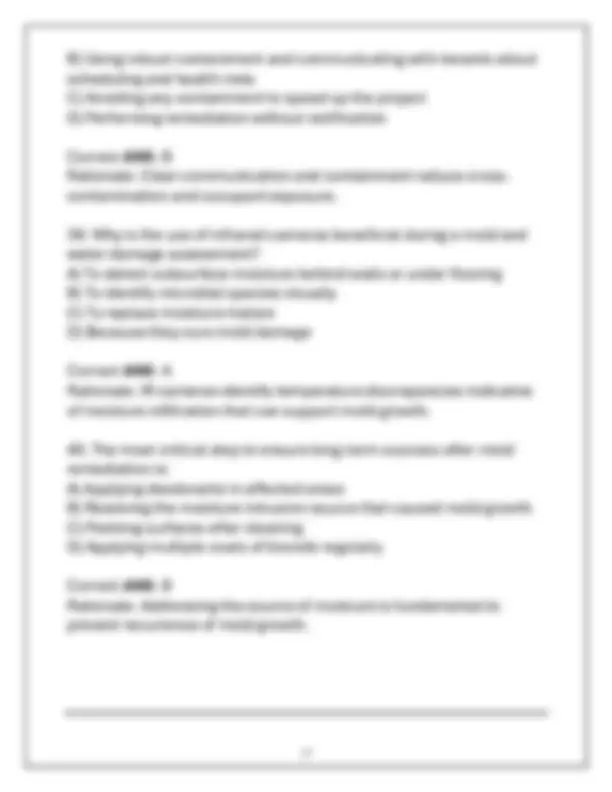Download Applied Microbial Remediation Technician Final Assessment Review 2025 and more Exams Advanced Education in PDF only on Docsity!
Applied Microbial Remediation
Technician
Final Assessment Review
(Questions & Solutions)
- Water Activity and Mold Growth Question: Which water activity (aw) level is crucial for preventing mold growth in remediated environments?
- (a) 0.
- (b) 0.
- (c) 0.
- (d) 0. Correct ANS : d) 0. Rationale: Mold growth is significantly inhibited when water activity is maintained below 0.80. This threshold helps ensure that the microenvironment does not support reproduction or survival of mold spores, making it a key parameter in moisture control during remediation.
- Advanced Sampling Techniques Question: Which advanced analytical method is most reliable for detecting and quantifying specific mold species in post-remediation clearance testing?
- (a) Culture-based methods
- (b) qPCR analysis
- (c) Spore trapping with microscopy
- (d) Air impaction sampling Correct ANS : b) qPCR analysis Rationale: qPCR (quantitative polymerase chain reaction) is favored because it
Correct ANS : b) Level B Rationale: Level B PPE provides chemical-resistant protection along with respiratory gear (such as a full-face respirator with a supplied air system) that is critical for both mold spores and sewage-borne pathogens. This level balances protection against biological hazards and chemical exposures.
- Airborne Mold Containment Question: To effectively contain airborne mold spores during large-scale remediation, which environmental control is most critical?
- (a) Positive pressure air filtration
- (b) Negative air pressure containment
- (c) Ambient air circulation
- (d) Stand-alone dehumidifiers Correct ANS : b) Negative air pressure containment Rationale: Negative pressure containment prevents contaminated air from flowing out of the remediation zone, thereby reducing the risk of cross-contamination in adjacent areas. This method is a cornerstone principle in safe mold remediation practices.
- Treatment of Porous vs. Non-Porous Materials Question: For mold remediation on porous materials (such as drywall) compared to non-porous materials (like metal), which method is most appropriate for porous materials?
- (b) HEPA vacuuming only
- (c) Replacement or encapsulation
- (d) Wet vacuuming Correct ANS : c) Replacement or encapsulation Rationale: Porous materials can harbor mold spores deep within their structure, making thorough cleaning very challenging. Removal or encapsulation is often recommended to eliminate hidden contamination and prevent re-growth.
7. Targeting Resilient Sewage Pathogens Question:
During sewage remediation, which class of pathogens typically requires the most stringent disinfection protocols due to its high resilience in water systems?
- (a) Viruses
- (b) Bacteria
- (c) Protozoan cysts
- (d) Fungi Correct ANS : c) Protozoan cysts Rationale: Protozoan cysts, such as those from Cryptosporidium or Giardia, are particularly resistant to traditional chlorine disinfection methods. Their hardy nature demands more robust treatment protocols.
8. Establishing Containment Barriers Question:
A remediation team encounters widespread mold growth in a commercial property. What is the most effective method to create a
- Differentiating Viable Organisms in Sampling Question: Which analytical technique best differentiates viable from non-viable mold organisms during post-remediation sampling?
- (a) Light microscopy
- (b) qPCR with viability dyes
- (c) Culture techniques on agar media
- (d) Immunoassay-based detection Correct ANS : b) qPCR with viability dyes Rationale: Combining qPCR with viability dyes allows technicians to target nucleic acids only from viable cells—providing a rapid and accurate assessment of the biological threat that remains post-remediation.
- Biocidal Agents in Mold Remediation Question: Which active ingredient is often preferred in biocidal cleaners during mold remediation for its broad-spectrum efficacy coupled with minimal residue?
- (a) Quaternary ammonium compounds (Quats)
- (b) Phenolic compounds
- (c) Hydrogen peroxide
- (d) Isopropyl alcohol Correct ANS : c) Hydrogen peroxide Rationale: Hydrogen peroxide is effective against a wide range of microorganisms including mold spores. Its decomposition into water and oxygen leaves minimal residue and poses a lower risk of secondary contamination.
- Proper Waste Disposal Protocols Question: During remediation, what is the essential protocol for disposing of contaminated materials?
- (a) Recycling without further treatment, if possible
- (b) Incineration without pre-treatment
- (c) Disposal as biohazard waste following local and federal regulations
- (d) Landfill disposal without special handling Correct ANS : c) Disposal as biohazard waste following local and federal regulations Rationale: Materials contaminated with biological hazards must be treated as biohazard waste. Adhering to strict disposal guidelines protects public health and complies with regulatory requirements.
- Confirming Remediation Success Question: Which criteria best confirm the successful mitigation of mold after remediation?
- (a) Visual inspection only
- (b) Combined post-remediation sampling with clearance testing standards
- (c) Air quality monitoring alone
- (d) Moisture level readings only Correct ANS : b) Combined post-remediation sampling with clearance testing standards Rationale: While visual inspection and moisture readings are useful, sampling
degradation and reduce health risks Rationale: Low VOC products help prevent further deterioration of indoor air quality during remediation by reducing the amount of harmful volatile compounds released into the environment.
- IICRC Remediation Standards Question: According to IICRC standards, which document should serve as the primary reference for establishing remediation protocols for microbial contamination?
- (a) EPA guidelines for biohazard management
- (b) ASTM standards for mold evaluation
- (c) IICRC S520 Standard for Professional Mold Remediation
- (d) OSHA guidelines Correct ANS : c) IICRC S520 Standard for Professional Mold Remediation Rationale: The IICRC S520 is the definitive industry standard outlining the procedures and best practices for mold remediation, making it essential reading for remediation professionals.
- Risk Assessment in Sewage Remediation Question: During the risk assessment phase of sewage remediation, which factor is most critical to evaluate?
- (a) The number of workers on site
- (b) Identification of potential pathogen exposure levels and chemical hazards
- (c) The building’s age
- (d) The cost of remediation Correct ANS : b) Identification of potential pathogen exposure levels and chemical hazards Rationale: A detailed risk assessment must focus on identifying and quantifying hazardous exposures—both biological and chemical—which drive the selection of proper remediation methods and PPE.
18. Influence of Structural Materials Question:
How does the type of structural material influence remediation strategies for mold contamination?
- (a) Denser materials always require chemical treatment
- (b) Porous materials often require removal or encapsulation, while non-porous materials can typically be effectively cleaned
- (c) The remediation approach is uniform regardless of material type
- (d) Non-porous materials should be replaced more often than porous ones Correct ANS : b) Porous materials often require removal or encapsulation, while non-porous materials can typically be effectively cleaned Rationale: Because porous materials can harbor mold deep within their structure, they are more challenging to remediate completely. In contrast, non-porous surfaces can be thoroughly disinfected, making targeted cleaning effective.
19. Combined Physical and Chemical Strategies
- Sewage Water Stabilization Processes Question: Which process sequence is essential for converting sewage- contaminated water into water safe for reuse or disposal?
- (a) Reverse osmosis only
- (b) Coagulation and flocculation followed by disinfection
- (c) Sedimentation alone
- (d) UV exposure without pre-treatment Correct ANS : b) Coagulation and flocculation followed by disinfection Rationale: The coagulation-flocculation process removes suspended particles and colloids, paving the way for effective subsequent disinfection. This multi-stage approach is fundamental for reducing microbial and chemical hazards in polluted water.
- Limitations of Ozone Treatment Question: What is a primary limitation of using ozone treatment during mold remediation?
- (a) It is too economical to implement
- (b) It does not effectively target fungal spores under high humidity conditions
- (c) It requires controlled exposure due to toxicity and potential material degradation
- (d) It increases indoor air quality beyond acceptable limits Correct ANS : c) It requires controlled exposure due to toxicity and potential material degradation Rationale:
Although ozone can disinfect effectively, its high oxidative potential can be dangerous for human health and may damage sensitive materials if not carefully controlled during application.
- Remediation of Contaminated HVAC Systems Question: In an HVAC system contaminated with mold spores, which remediation method is most appropriate?
- (a) Replacing the entire HVAC system immediately
- (b) Duct cleaning combined with chemical disinfection and UV light treatment
- (c) Sole reliance on UV light treatment
- (d) Sealing the HVAC system and isolating it from use Correct ANS : b) Duct cleaning combined with chemical disinfection and UV light treatment Rationale: A multi-pronged approach—including mechanical cleaning, targeted chemical disinfection, and UV light application—ensures that both accumulated spores and any biofilm present in ductwork are effectively addressed.
- Handling Severely Contaminated Porous Materials Question: What is the recommended approach for managing severely contaminated porous materials?
- (a) Attempt in situ cleaning
- (b) Seal the area and monitor over time
- (c) Removal, safe demolition, and proper hazardous waste disposal
- (d) Utilize only chemical treatments to salvage the material
- (b) High-pressure air cleaning
- (c) Pre-wetting surfaces prior to disturbance
- (d) Immediate heat drying Correct ANS : c) Pre-wetting surfaces prior to disturbance Rationale: Pre-wetting surfaces before removal significantly reduces the aerosolization of bioaerosols, protecting workers and the surrounding environment from inadvertent spread of contaminants.
27. Sewage Wastewater Decontamination Question:
Which combination of processes is most effective in reducing microbial loads and neutralizing contaminants in sewage remediation?
- (a) Sedimentation followed by chlorination
- (b) Filtration, advanced oxidation processes, then chlorination
- (c) Simple pH adjustment
- (d) Mechanical agitation alone Correct ANS : b) Filtration, advanced oxidation processes, then chlorination Rationale: A multi-barrier treatment that begins with mechanical filtration to remove particulates, followed by advanced oxidation to break down complex contaminants, and final chlorination for disinfection, ensures thorough remediation of sewage wastewater.
28. Effective Risk Communication Question:
Which strategy is most critical for risk communication during
remediation work involving both mold and sewage contamination?
- (a) Using technical jargon without explanation
- (b) Clearly communicating remediation steps, timelines, and potential health risks in accessible language
- (c) Minimizing the amount of information to avoid panic
- (d) Restricting communication to internal staff only Correct ANS : b) Clearly communicating remediation steps, timelines, and potential health risks in accessible language Rationale: Transparent, clear, and accessible communication helps build trust and ensures that all stakeholders understand the remediation process and any associated hazards, facilitating better cooperation and compliance.
29. Enhanced PPE for High-Risk Sewage Areas Question:
For high-risk sewage remediation zones, what additional PPE measure is recommended beyond standard chemical-resistant suits?
- (a) Use of surgical masks
- (b) Full-face respirators with supplied air systems
- (c) Regular work gloves
- (d) Safety goggles alone Correct ANS : b) Full-face respirators with supplied air systems Rationale: In particularly hazardous environments, full-face-powered or supplied-air respirators provide enhanced respiratory protection against a range of airborne pathogens, chemical vapors, and other contaminants.
compliance with established protocols but also for liability, post- remediation verification, and continuous quality improvement in remediation practices.
- Remediation Approach: Mold vs. Sewage Question: What is the primary distinction between remediation approaches for mold versus sewage contamination?
- (a) Mold remediation relies solely on chemical disinfection while sewage remediation does not
- (b) Sewage remediation focuses on neutralizing biological hazards and chemical contaminants, whereas mold remediation emphasizes spore removal and moisture control
- (c) Both practices use identical techniques
- (d) Mold remediation is invariably more resource-intensive than sewage remediation Correct ANS : b) Sewage remediation focuses on neutralizing biological hazards and chemical contaminants, whereas mold remediation emphasizes spore removal and moisture control Rationale: Each type of contamination presents unique hazards. Sewage contains complex mixtures of pathogens and chemicals needing neutralization, while mold remediation concentrates on controlling moisture and removing spores from affected surfaces.
- Advantages of qPCR over Culture Question: What is a significant advantage of using qPCR over traditional culture techniques during microbial investigations in remediation?
- (a) qPCR is generally cheaper and easier to perform on site
- (b) It provides rapid and specific identification of organisms, including those that are difficult to culture
- (c) Culture methods are faster in obtaining results
- (d) qPCR does not necessitate sample preparation Correct ANS : b) It provides rapid and specific identification of organisms, including those that are difficult to culture Rationale: qPCR offers high sensitivity and specificity, rapidly amplifying even trace amounts of DNA from challenging-to-culture organisms. This advantage is paramount for timely decision-making during remediation projects.
34. Consulting IICRC Guidelines Question:
When encountering unforeseen microbial contamination scenarios, at which point should technicians consult updated IICRC guidelines?
- (a) Only after remediation is complete
- (b) Continuously at every stage, from initial assessment through post-remediation testing
- (c) Only during the initial assessment
- (d) Only when legal issues arise Correct ANS : b) Continuously at every stage, from initial assessment through post-remediation testing Rationale: Constant reference to current IICRC guidelines ensures that the remediation approach remains compliant with best practices, allowing technicians to adapt promptly to any unforeseen challenges.
35. Mycotoxin Testing Necessity

